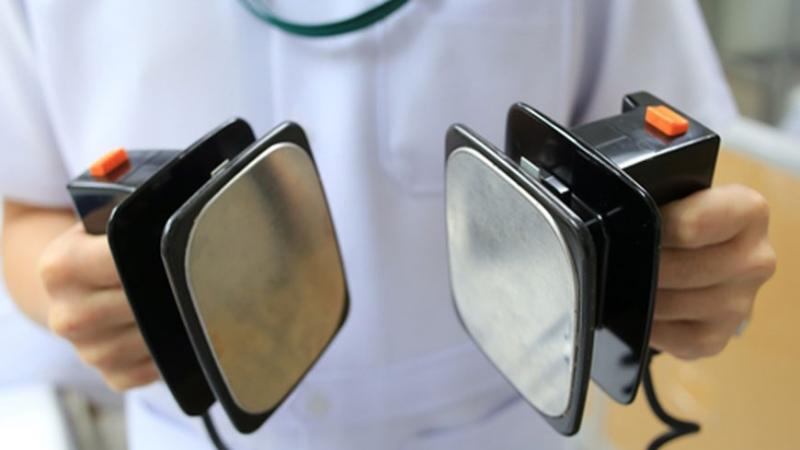Defibrillators are medical devices that administer electric shock to restore normal heart rhythm in patients suffering from ventricular fibrillation or pulseless ventricular tachycardia. Key functions of defibrillators include delivery of shock, monitoring of heart rhythms, and cardiac output. Main types of defibrillators available are implantable cardioverter defibrillators (ICDs) and external defibrillators. ICDs are small battery-powered devices implanted inside the body to monitor heart rhythm and deliver shock if needed. External defibrillators include manual defibrillators, automated external defibrillators (AEDs), and wearable cardioverter defibrillators (WCDs) used outside the hospital settings. Rising prevalence of cardiovascular diseases and growing focus on public access defibrillation programs are major factors driving the demand for defibrillators. The Global Defibrillators Market is estimated to be valued at US$ 16,843.5 Mn in 2024 and is expected to exhibit a CAGR of 5.7% over the forecast period 2023 to 2030.
Key Takeaways
Key players operating in the defibrillators market are Koninklijke Philips N.V., Metrax GmbH, Medtronic, Mindray Medical International Limited, Boston Scientific Corporation, GE Healthcare, Nihon Kohden, Abbott, BIOTRONIK, Stryker, and LivaNova PLC. Philips and Medtronic collectively hold over half of market share owing to their diverse defibrillator product portfolio and strong geographical presence.
The demand for defibrillators is growing due to rising economic burden of target diseases and increasing number of public access defibrillation programs worldwide. As per WHO, cardiovascular diseases claim over 17.9 million lives each year and are the leading cause of death globally. This creates high demand for treatment and monitoring devices like defibrillators.
Technological advancements are expanding indications for defibrillators. Advanced features such as remote monitoring, enhanced connectivity, and Miniaturization of implantable devices are enhancing patient outcomes. Wearable defibrillators provide safe protection against sudden cardiac arrest for patients not qualified for implantable devices.
Market Trends
1. Advancements in remote monitoring technology: Major players are focusing on integration of remote monitoring capabilities in defibrillators. This allows continuous transmission of device settings and cardiac rhythms to clinicians for timely diagnosis and intervention.
2. Rise in preference for non-invasive defibrillators: Non-invasive defibrillators like AEDs and wearable defibrillators are gaining popularity due to benefits like ease of use, portability, and real-time arrhythmia detection for prompt treatment.
Market Opportunities
1. Untapped emerging markets: Emerging countries in Asia Pacific and Latin America provide major opportunities due to improving access to healthcare services and increasing healthcare spending.
2. Development of cost-effective devices: There is a need for affordable and easy to use defibrillators to maximize coverage of defibrillation programs globally. Integration of new technologies can help reduce costs.
The defibrillators market will grow at highest pace owing to rising prevalence of cardiovascular diseases coupled with advancement in remote monitoring technologies and preference for non-invasive devices.
Impact of COVID-19 on Defibrillators Market Growth
The COVID-19 pandemic has significantly impacted the growth of the defibrillators market. During the initial outbreak, many elective procedures and non-essential medical device purchases were postponed to divert resources towards treating COVID-19 patients. This led to a decline in the demand and sales of defibrillators in 2020. However, with the progression of vaccination drives and easing of restrictions globally post mid-2021, the defibrillators market has been recovering steadily.
The pre-COVID forecasts anticipated robust growth in the demand for defibrillators driven by the rising incidence of cardiovascular diseases, growing geriatric population and technological advancements. However, the pandemic temporarily disrupted supply chains and postponed procurement decisions of hospitals and healthcare facilities. Going forward, the market is expected to pick up momentum and surpass the pre-pandemic projections over the forecast period from 2023 to 2030. Growth will be fuelled by recovering healthcare spending, continued launch of advanced devices and emphasis on preparedness for future healthcare emergencies. Market players will need to focus on strengthening distribution networks, building inventory levels and streamlining production capacities to cater to the increasing demand in the post-pandemic landscape.
Geographical Regions Where Defibrillators Market is Concentrated in Terms of Value
North America dominates the defibrillators market and accounts for the largest share of the overall market value. This can be attributed to factors such as the high prevalence of heart diseases, growing elderly population, favourable reimbursement policies, rising acceptance of automated external defibrillators (AEDs) and presence of major industry players in the region. Within North America, the United States represents the most valuable market for defibrillators.
Fastest Growing Region for Defibrillators Market
Asia Pacific is expected to be the fastest growing region in the defibrillators market during the forecast period from 2023 to 2030. This can be credited to a surge in healthcare expenditures, increasing healthcare infrastructure developments, growing incidence of cardiac arrests, favourable government initiatives and rising medical tourism in emerging countries such as China and India. Additionally, rising awareness about public-access defibrillators (PAD) programs is boosting the adoption of AED devices in corporate offices, airports and community centres across Asia Pacific economies.
